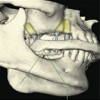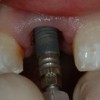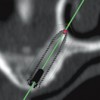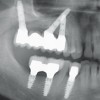Centric occlusion is often distant from centric relation in partially edentulous patient because of unfavorable jaw relations, super-erupted teeth etc. Topics addressed include assessment of the existing vertical dimension of occlusion (VDO) and determining the proper VDO, assessing the horizontal occlusal relationship (centric occlusion vs centric relationship) and making centric relation records. The use of treatment RPD’s in determining the proper VDO is discussed. The criteria used to determine the scheme of occlusion are also outlined.
Maxillo-Mandibular Records and Occlusion for RPD’s — Course Transcript
- 1. Maxillo-mandibular records and Occlusion for RPD’s Michael Hamada DDS George Perri DDS John Beumer III DDS, MS and Ting Ling Chang DDS Division of Advanced Prosthodontics, Biomaterials and Hospital Dentistry UCLA School of Dentistry This program of instruction is protected by copyright ©. No portion of this program of instruction may be reproduced, recorded or transferred by any means electronic, digital, photographic, mechanical etc., or by any information storage or retrieval system, without prior permission.
- 2. Maxillo-mandibular records and Occlusion for RPD’s
- 3. Maxillo-mandibular records Assessment of the existing VDO and occlusion Determine the proper VDO for the patient Assess the horizontal occlusal relationship Centric occlusion vs centric relation Make jaw relation records
- 4. Assessment of the VDO Acceptable VDO: Vertical stops (posterior tooth contacts) maintained without tooth displacement or horizontal interference with the correct physiological function. When an existing VDO is correct, there often exists sufficient inter-jaw space for denture teeth and proper occlusal guidance .
- 5. Assessment of the VDO During speech there is little or no contact between the dentition in the opposing dental arches Assess the interocclusal space. It averages 2-4 mm When an existing VDO is acceptable, preserve it
- 6. Assessment of the VDO Loss of interocclusal space does not always imply loss of VDO Super-eruption of teeth commonly leads to loss of interocclusal space
- 7. Assessment of the VDO When an existing VDO is correct, there usually is sufficient space for positioning denture teeth In some patients however, even though the existing VDO is correct super-eruption of teeth may need correction before the RPD is made
- 8. Assessment of the VDO In these patients the vertical dimension of occlusion has been lost or reduced There are no posterior occlusal stops remaining in either patient A treatment plan will require reestablishment of a vertical dimension occlusion compatible with speech and swallowing
- 9. Assessment of the VDO Phenomenon that lead to reduced VDO Loss of multiple tooth contacts through tooth loss and migration of teeth
- 10. Assessment of the VDO Phenomenon that lead to reduced VDO Excessive wear Courtesy Dr. A Davodi Courtesy Dr. A Davodi
- 11. Reestablishing the proper VDO When it is believed that the VDO needs to be restored it is necessary to fabricate a temporary partial denture (treatment partial denture) The new VDO is assessed by observing speech and swallowing. After a period of wear by the patient, the VDO is reassessed. If correct, the new RPD is fabricated at this VDO The minimum diagnostic trial period is 3-4 weeks Courtesy Dr. A Davodi Courtesy Dr. A Davodi
- 12. Reestablishing the proper VDO This patient presented with a reduced VDO secondary to wear and erosion The current VDO is assessed by observing speech and swallowing. The interocclusal space was excessive, and temporary treatment RPD’s were planned Courtesy Dr. A Davodi Courtesy Dr. A Davodi
- 13. Reestablishing the proper VDO Treatment Partial Dentures Purpose Replace missing teeth Establish posterior occlusion Test changes in vertical dimension Trial prostheses—Can the patient adapt to RPD’s Note the occlusal rests on both treatment RPD’s Courtesy Dr. A Davodi Courtesy Dr. A Davodi
- 14. Reestablishing the proper VDO Treatment Partials Note occlusal platform on maxillary treatment partial to restore patient’s vertical dimension Courtesy Dr. A Davodi Courtesy Dr. A Davodi Courtesy Dr. A Davodi
- 15. Reestablishing the proper VDO A new VDO will be determined by observing freeway space, phonetics and swallowing position Changes are made as deemed appropriate A minimum diagnostic trial period for the treatment RPD is 3 to 4 weeks. Courtesy Dr. A Davodi
- 16. Determination of the proper VDO Incorrect horizontal relationships usually accompany an incorrect VDO When there are occlusal interferences caused by malpositioned teeth, it is necessary to eliminate the interference before the proper VDO can be determined
- 17. Centric Relation (CR) The relation of the mandible to the maxillae when the condyles are in their most anterior/superior position in the glenoid fossa from which unstrained lateral movements can be made at the occluding vertical dimension normal for the individual Unstrained Orthopedic relationship Attributed to Restraining action of Ligaments Muscles Meniscus
- 18. Centric Relation (CR) The relation of the mandible to the maxillae when the condyles are in their most anterior/superior position in the glenoid fossa from which unstrained lateral movements can be made at the occluding vertical dimension normal for the individual On the border of the envelope of mandibular motion (at intersection of right and left border positions) Is part of the functional range of motion during chewing & swallowing CR
- 19. Centric Jaw Relation (CR) The relation of the mandible to the maxillae when the condyles are in their most anterior/superior position in the glenoid fossa from which unstrained lateral movements can be made at the occluding vertical dimension normal for the individual CR is the only constant repeatable position at which to start a stable occlusion And from which smooth gliding non-interfering movements to a comfortable muscular position are possible CR
- 20. Centric Jaw Relation (CR) The relation of the mandible to the maxillae when the condyles are in their most anterior/superior position in the glenoid fossa from which unstrained lateral movements can be made at the occluding vertical dimension normal for the individual Unstrained Orthopedic relationship Learnable Repeatable Recordable CR
- 21. When do we use Centric Occlusion? Centric relation – The most retruded relation of the mandible to the maxilla, when the condyles are also in the most retruded unstrained position in the glenoid fossa. This position corresponds to the apex of bilateral movement in Gothic Arch tracing. Glenoid fossa Disc Condyle Articular eminence CR
- 22. When do we use Centric Relation? The Centric Relation position is especially useful when existing occlusion is lost or distorted. When one arch is edentulous CR
- 23. Centric Relation vs Intercuspation and Centric Occlusion Maximum intercuspation (centric occlusion) in a healthy dentition is usually .5 to 1.0 mm anterior to centric relation
- 24. When do we use Centric Occlusion? If a diagnostic evaluation determines that no disease or adverse symptoms are occurring within the entire supporting masticatory system, the existing jaw relationship is considered acceptable.
- 25. Centric Jaw Relation: When do we use it? The rationale for use of this jaw position is that the position can be repeated and reproduced by duplicate records which do not depend on the patients neuro-muscular system. Because of the most retruded position, we might remove the possibility of occlusal interference . Glenoid fossa Disc Condyle Articular eminence CR
- 26. Assessment of the horizontal relationships It is ideal when the horizontal relationship determined by positional tooth contact (Centric Occlusion) or tapping is coincident with or within one mm of centric relation. If the discrepancy is excessive, use of a TX RPD is recommended to determine the desired centric occlusion position . CR
- 27. Jaw relation records Face bow transfer record Centric jaw position record Protrusive position record Adjustment of condylar inclination Record the protrusive position of the mandible, when the anterior teeth are edge to edge contact or 3-6 mm protrusive position from the centric relation position
- 28. Jaw relation records In most cases involving a distal extension base RPD, record bases are required. Record bases have to be well adapted to the cast and intraorally to the tissue surface. The reliability of the registration depends on support from the edentulous mucosa being equal to the support that will be provided by the final prosthesis.
- 29. Jaw relation records Wax rims ideally should represent the buccal-lingual contour of the teeth being replaced and be positioned to record the opposing dentition or wax rim. Wax rims must be well adapted and stable.
- 30. Jaw relation records Face bow record Wax rims have to be adjusted until consistent occlusal clearance is achieved. Undesirable contacts will guide and distort the records The bite registration material should exert no opposition or interference to jaw closure. Avoid applying an excessive amount of the material. When sufficient tooth contacts remain, orient the mandible accordingly. Especially when the edentulous area is extensive, patients should understand and rehearse the procedures under doctor’s instruction for accurate and reliable registration.
- 31. Jaw relation records Make face bow transfer record The face bow transfer record orients the maxillary cast on the articulator in a proper position relative to the condyles.
- 32. Jaw Relation Registration with record bases and wax rims In some cases involving a distal extension base RPD, record bases are required. Record bases should be well adapted to the cast and intraorally to the tissue surface. The reliability of the centric position registration depends on support from the edentulous mucosa being equal to the support that will be provided by the final prosthesis.
- 33. Jaw Relation Registration with record bases and wax rims Wax rims ideally should represent the buccal-lingual contour of the teeth being replaced and be positioned to record the opposing dentition or wax rim.
- 34. Jaw Relation Registration with record bases and wax rims Centric jaw position record mounted on the articulator Protrusive position record is made and the condylar inclination is adjusted accordingly
- 35. Altered cast – CR record Mount the tentative centric relation record with the compound occlusal index This record must be verified at the try-in appointment Only reliable and time saving in experienced hands
- 36. Occlusal Considerations General Occlusal Considerations Biologic/Organic Occlusion Complete Denture Occlusion Removable Partial Denture Occlusion Restorative Considerations Anterior Guidance vs. Fully Balanced Occlusion RPD’s Opposing Complete Dentures Class II and Class III Occlusions Prosthetic Tooth Selection Morphology and Materials Considerations
- 37. Natural Dentition: Organic Occlusion Characterized by: Bilateral Posterior Centric Contact Anterior Guidance Mutually Protective Scheme of Occlusion
- 38. Denture teeth are part of the denture base which rests on movable/displaceable tissues Premature, deflective contacts between artificial teeth cause movement of the denture resulting in damage to the supporting tissues. Complete denture occlusion – Bilateral balance Why?
- 39. Developing occlusion Bilateral balance vs anterior guidance and or group function Weakest arch dictates the occlusal scheme Whenever one arch is edentulous, bilateral balanced occlusion is employed Otherwise the denture will tip and move during mastication and parafunction and the edentulous arch will rapidly resorb
- 40. Complete denture opposing RPD Bilateral Balanced Occlusion: When the opposing arch requires prosthetic stabilization When a complete denture is opposed by a RPD, it is necessary to develop balanced occlusion in all eccentric positions.
- 41. Complete Dentures Opposing an Extension Base RPD Protrusive position Centric occlusion The vertical overlap of the anterior teeth was excessive and with the patient in the protrusive position there are no posterior contacts. As a result the denture is tipped anteriorly during function leading eventually to severe resorption of the premaxilla What are the consequences of not developing bilateral balanced occlusion?
- 42. Maxillary Denture Opposing a Kennedy Class I RPD Severely resorbed premaxilla As a result the denture is tipped anteriorly during function leading eventually to severe resorption of the premaxilla What are the consequences of not developing bilateral balanced occlusion?
- 43. Complete denture opposing RPD Bilateral Balanced Occlusion: When the opposing arch requires prosthetic stabilization When a complete denture is opposed by a RPD, it is necessary to develop balanced occlusion in all eccentric positions.
- 44. Complete denture opposing Kennedy Class I RPD Patient presents with edentulous maxilla opposing a partially dentulous mandible requiring a Kennedy Class I RPD Note the molar teeth tilted mesially and the occlusal plane discrepancies. Bilateral balanced occlusion must be employed, otherwise the edentulous maxilla will resorb rapidly Courtesy Dr. GE KIng
- 45. Complete denture opposing Kennedy Class I RPD Bilateral balanced occlusion must be employed, otherwise the edentulous maxilla will resorb rapidly Bilateral balanced occlusion requires that the plane of occlusion be restored and tooth contours be made more favorable. This can be accomplished with fixed restorations or an RPD Courtesy Dr. GE KIng Courtesy Dr. GE KIng
- 46. Complete Denture Opposing Kennedy Class I RPD The occlusal plane discrepancies and occlusal contours have been restored with an overlay RPD as well as the missing dentition making it possible to develop bilateral balanced occlusion. Courtesy Dr. GE KIng Courtesy Dr. GE KIng Courtesy Dr. GE KIng
- 47. Developing Occlusion Anterior guidance- – protects against overload and occlusal interference on posterior teeth The location and number of remaining teeth determine anterior guidance. Is always preferred for a distal extension partial The magnitude of the canine guidance will create posterior disclusion.
- 48. Bilateral distal extension RPD’s In such a patient anterior guidance is preferred
- 49. Developing occlusion Occlusal plane- base line for organized and compatible inter-arch set up. The ideal occlusal plane is an imaginary line that connects the middle third of the retromolar pad and maxillary incisal edges, when the jaws are at the correct VDO.
- 50. Occlusal plane- base line for organized and compatible inter-arch set up. The ideal occlusal plane is an imaginary line that connects the middle third of the retromolar pad and maxillary incisal edges, when the jaws are at the correct VDO. Supererupted teeth off the occlusal plane create interferences. Developing Occlusion
- 51. Developing Occlusion We prefer a lingualized form of occlusion With this occlusal scheme it is less likely that there will occlusal contact during excursions Kennedy Class II RPD
- 52. Developing Occlusion Anterior guidance restored with full veneer crowns Lingualized scheme of occlusion was used in the posterior region Kennedy class I RPD
- 53. Developing Occlusion Rather than filling the edentulous space, place posterior teeth in the most advantageous position for centric and eccentric positions. If the first tooth is located in an ideal position, the following teeth can be organized in their ideal positions. Esthetic difficulties, such as reduced mesial-distal or inter-dental space, can be rectified by altering, recontouring teeth, adding tooth colored acrylic, or leaving a slight space.
- 54. Developing Occlusion Rather than filling the edentulous space, place posterior teeth in the most advantageous position for centric and eccentric positions. If the first tooth is located in an ideal position, the following teeth can be organized in their ideal positions. Esthetic difficulties, such as reduced mesial-distal and inter-dental space, can be rectified by altering, recontouring teeth, adding tooth colored acrylic, or leaving a slight space.
- 55. Developing Occlusion Controlling and preserving remaining oral structures is a prime objective in RPD treatment. The replacement of key structures or mastication surfaces may not be proper treatment if it jeopardize the health or survival of a remaining structure. Developing proper occlusion may be the key to preventing further loss or damage. Proper occlusion must take into account: Occlusal plane Anterior guidance Condylar guidance Occlusal scheme
- 56. Complete Denture vs. RPD: Skeletal Class II Maxillary arch is edentulous Occlusion therefore will be bilateral balance Courtesy Dr. T Berg
- 57. Complete Denture vs. RPD: Skeletal Class II Study cast surveyed RPD is designed Tooth contours will be modified with either fixed restorations or recontouring the enamel of the existing teeth to facilitate the development of bilateral balanced occlusion Courtesy Dr. T Berg
- 58. Complete Denture vs. RPD: Skeletal Class II Lower study cast is mounted in centric relation with a maxillary master cast made with a border molded impression Diagnostic wax-up is completed consistent with obtaining bilateral balanced occlusion with the planned opposing complete denture Courtesy Dr. T Berg Courtesy Dr. T Berg
- 59. Complete Denture vs. RPD: Skeletal Class II Completed maxillary wax up Note the horizontal overlap Patient will tend to function down and forward during speech and swallowing Courtesy Dr. T Berg
- 60. Complete Denture vs. RPD: Skeletal Class II Semi-anatomic teeth are chosen to accommodate for the so-called protrusive convenient positions Full veneer crowns are planned for the left mandibular premolar and the right mandibular cuspid Courtesy Dr. T Berg
- 61. Complete Denture vs. RPD: Skeletal Class II The teeth are prepared, impressions are made, a centric relation record is obtained and the cast containing the dies is mounted as shown Courtesy Dr. T Berg
- 62. Complete Denture vs. RPD: Skeletal Class II Crowns are contoured to: Restore the proper level of the occlusal plane Provide ideal contours to develop bilateral occlusion with opposing complete denture Courtesy Dr. T Berg
- 63. Complete Denture vs. RPD: Skeletal Class II Partial denture is then completed in the usual manner Impression for RPD framework RPD framework fabricated, physiologically adjusted Altered cast impression Centric relation records Try in and prove centric relation record The occlusal plane has been modified to enable the development of bilateral balanced occlusion Courtesy Dr. T Berg Courtesy Dr. T Berg
- 64. Complete Denture vs. RPD: Skeletal Class II Note the occlusion has been modified to allow the patient to function in a more anterior position and everywhere in between This is accomplished with a protrusive record and modifying the occlusal contours of the semi-anatomic denture teeth Courtesy Dr. T Berg Courtesy Dr. T Berg Courtesy Dr. T Berg
- 65. Complete Denture vs. RPD: Skeletal Class II In such cases it may not possible to develop cusp to cusp and tooth to tooth balance A balancing ramp (circle) was used to obtain bilateral balanced occlusion Courtesy Dr. T Berg Courtesy Dr. T Berg
- 66. Complete Denture vs. RPD: Skeletal Class II Inserted RPD Despite the malposition of some teeth, the RPD reestablishes the integrity of the arch and restores the occlusal plane enabling the development of bilateral balanced occlusion The occlusal scheme based on the status of the weakest arch Courtesy Dr. T Berg
- 67. Complete Denture vs. RPD: Skeletal Class II Sometimes the morphology of the natural dentition does not permit the freedom of anterior movement in function to maintain bilateral balanced occlusion Using trans-occlusal rests may be modified to provide an occlusal morphology that permits the range of movement required between centric relation and the more anterior centric occlusion position
- 68. Complete Denture vs. RPD: Skeletal Class III Maximum intercuspation may be anterior to centric relation May be exaggerated by loss of posterior teeth and loss of vertical dimension
- 69. Complete Denture vs. RPD: Skeletal Class III Mounted study casts in centric relation position If you compare with the previous clinical slide you can see the position is more edge to edge Courtesy Dr. T Berg Courtesy Dr. T Berg
- 70. Complete Denture vs. RPD: Skeletal Class III Condylar inclination needs to be recorded so that the patient can be placed in a protrusive position that is compatible with their maximum intercuspation position Courtesy Dr. T Berg
- 71. Complete Denture vs. RPD: Skeletal Class III Lateral incisors were restored with full veneer crowns Note the cingulum rests Courtesy Dr. T Berg
- 72. Complete Denture vs. RPD: Skeletal Class III Following completion of the fixed restorations the RPD is fabricated Total palatal coverage was used to maximize support Note the positive cingulum rests These will prevent the incisors from being displaced anteriorly Courtesy Dr. T Berg
- 73. Complete Denture vs. RPD: Skeletal Class III Reestablishment of the posterior support and the vertical dimension of occlusion and the development of positive cingulum rests is essential for maintaining the health of the arch as a functional unit. Courtesy Dr. T Berg Courtesy Dr. T Berg
- 74. Complete Denture vs. RPD: Skeletal Class III Restoration of the vertical dimension and providing posterior occlusion prevents continued wear of the remaining incisors Guidance is provided by the natural incisors However, most class III patient present with vertical chewing motions Note the esthetic result Courtesy Dr. T Berg Courtesy Dr. T Berg
- 75. Anterior Extension RPD’s Kennedy Class IV Challenges regarding occlusion Phonetics and esthetics dictate the position of the anterior teeth The anterior teeth may be cantilevered significantly anteriorly Courtesy Dr. GE KIng Courtesy Dr. GE KIng Courtesy Dr. GE KIng
- 76. Anterior Extension RPD’s Kennedy Class IV Challenges regarding occlusion Phonetics and esthetics dictate the position of the anterior teeth The anterior teeth may be cantilevered significantly anteriorly as a result
- 77. Anterior Extension RPD’s Kennedy Class IV Challenges regarding occlusion Phonetics and esthetics dictate the position of the anterior teeth The anterior teeth may be cantilevered significantly anteriorly Courtesy Dr. GE KIng Courtesy Dr. GE KIng Courtesy Dr. GE KIng
- 78. Anterior Extension RPD’s Kennedy Class IV Maintain guidance with natural dentition In this patient the cuspids and premolars provided anterior guidance Note there is no contact with the incisors during lateral excursion
- 79. Anterior Extension RPD’s Kennedy Class IV In this patient guidance in lateral excursions was provided by the cuspids and the premolars Courtesy Dr. GE KIng Courtesy Dr. GE KIng
- 80. Anterior Extension RPD’s Kennedy Class IV Note the absence of retainers This is a rotational path RPD
- 81. Conclusion RPD occlusion lies somewhere in the continuum between the completely edentulous arch and the intact, healthy complete dentate arch Requirements for RPD occlusion will be dependent on the requirements for the weakest arch Bilateral balance vs anterior guidance
- 82. Conclusion Within the constraints of the “weakest arch” the type of guidance established is dependent upon the condition, number and position of the remaining anterior teeth (sometimes including the 1 st premolar in the case of Kennedy Class IV RPD’s) Once determined and established, maintenance of the occlusion is critical for the long term health of the dentition Restorative materials choices Maintenance and recalls are most important
- 83. Visit ffofr.org for hundreds of additional lectures on Complete Dentures, Implant Dentistry, Removable Partial Dentures, Esthetic Dentistry and Maxillofacial Prosthetics. The lectures are free. Our objective is to create the best and most comprehensive online programs of instruction in Prosthodontics


 Angled Implants
Angled Implants
 Single Tooth Defects in Posterior Quadrants
Single Tooth Defects in Posterior Quadrants
 Prosthodontic Procedures and Complications
Prosthodontic Procedures and Complications
 Restoration of Posterior Quadrants and Treatment Planning
Restoration of Posterior Quadrants and Treatment Planning
